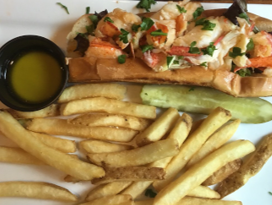Lobster Rolls: What Makes an Authentic Lobster Roll So Delicious | Geddy’s
Of all the famous foods in New England, the lobster roll are perhaps the most hotly debated.
Hot or cold? Butter or mayonnaise? Celery or lettuce? Who made the first lobster roll? Who makes the best lobster roll?
If you’re not from New England, this may seem like a trivial argument. But rest assured that when you experience your first taste of an authentic lobster roll, you will understand the hype.
One bite of that sweet, buttery, toasted goodness–and your life will change forever.
Not convinced? Read on to learn all about lobster rolls and what makes them so delicious. (Warning: You will be hungry by the end of this post!)
A Brief History of Lobster (As Food)
Lobster may be one of the most decadent foods of our modern era, but it wasn’t always that way. In fact, back in colonial times, lobsters were considered “poor man’s food” and fed to slaves and prisoners!
Let’s consider a few fascinating facts about our (tasty) friend, the lobster:
- When the first Europeans arrived in America, they found piles of lobsters on the beaches–sometimes up to two feet high!
- Native Americans (and early settlers) used lobsters to bait their fishing hooks and used lobster shells as fertilizer
- Servants in colonial Massachusetts got so tired of lobster they started including stipulations in their contract not to eat it more than twice a week
So when did everything change?
In 1876, the first lobster pound was founded in Vinalhaven, Maine. By the turn of the century, discriminating diners in New York City and Boston began to get a taste for the humble lobster.
By the start of World War II, lobster was elevated from a poor man’s food to a gourmet delicacy. Interestingly, it was among the few foods that weren’t rationed during the war years.
The result? America ate lobster to its hearts’ content–and has been in love with it ever since.
What’s So Special About Lobster Anyway?
Here’s a little-known fact: Lobsters have some of the strangest anatomy in the animal kingdom.
How’s this for unique?
- A lobster’s brain is in its throat.
- Its teeth are in its stomach.
- Its nervous system is inside its abdomen.
- Its kidneys are in its head.
- A lobster hears with its legs and tastes with its feet.
Confused? So are we. But regardless of its bizarre anatomy, one thing we can all agree on is its wonderful flavor.
Though viewed as a rich and decadent food source, lobster meat is actually very good for you. In fact, four ounces of lobster meat contains fewer calories than four ounces of chicken breast.
Not only is lobster tasty, but it’s packed full of vital nutrients. A helping of lobster boasts heart-healthy omega-3 fatty acids and potassium. It’s also rich in vitamins E, B6, and B12.
What’s a Lobster Roll?
Now that you know more about this delicious crustacean, it’s time to discuss the topic at hand.
The first known lobster roll was served in 1929 in Milford, Connecticut at a restaurant called Perry’s. It gained popularity in the 1960s at a Long Island seafood restaurant appropriately named The Lobster Roll.
Then, in 1970s Maine, summertime roadside stands began serving up chilled lobster meat in toasted hot dog buns.
Who can lay claim to this sandwich? Everyone, it seems, because the lobster roll is now a staple of nearly every seafood restaurant in New England.
But here comes the tricky part. What’s the best style of lobster roll?
There are two main variations of lobster rolls:
- Traditional: Warm chunks of lobster meat soaked in butter, served on a steamed hot dog bun
- Maine-style: Cold chunks of lobster on a toasted bun, with or without a spread of mayonnaise
Everyone has their personal favorite, of course, but both styles are equally delicious. Nowadays, chefs are also putting their own unique twist on the traditional or Maine-style lobster rolls.
Some restaurants feature a “lobster salad” type roll where the meat is mixed with lemon, mayonnaise, salt, pepper, or paprika. Some versions feature celery or lettuce, while others include only the meat and bread.
For those who want to please everyone, some menus feature both a hot and a cold lobster roll.
What Makes a Lobster Roll “Authentic?”
As you can see, there’s more to the lobster roll than first meets the eye. Styles, tastes, and opinions abound, but there are definite standards for an “authentic” lobster roll.
The first focuses on simplicity. Because lobster has such a sweet, delicate flavor, strong seasoning or sauces easily overpower it.
Discerning chefs know that only a little flavor enhancement–a dash of lemon or a touch of mayonnaise–is all that’s needed for a delicious lobster roll.
There’s no need for fancy sauces or a blend of spices because these would only detract from the star of the show–the lobster itself.
Another deciding factor in its authenticity? Location. If you want to experience a true and honest New England lobster roll, well…you need to go to New England to get it.
A final factor to a great lobster roll is fresh lobster. Frozen, pre-packaged lobster meat can’t compete with the off-the-boat version.
We applaud McDonald’s for giving it a try–but lobster rolls are best left to the seafood experts.
Hungry? Where to Go for the Best Lobster Rolls
Is your stomach rumbling? Wondering where to go to experience an authentic lobster roll firsthand?
Here at Geddy’s, we take pride in preparing delicious New England cuisine–including lobster rolls. Click here to peruse our menu, which has something for everyone!
And if you’d like to learn more about lobsters, Bar Harbor, or Maine in general, check out our latest blog posts.
We’ll see you soon–and come hungry!
Cheers from Geddy’s,:)
Heather







